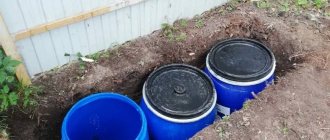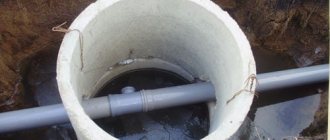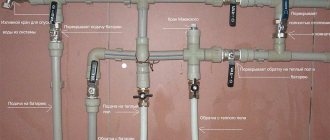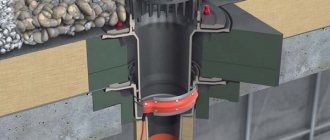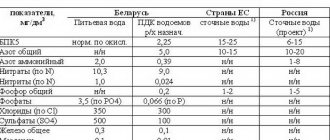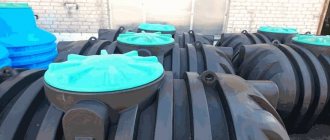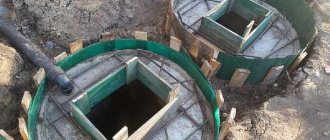A septic tank (autonomous sewage system) is an engineering system for the accumulation, storage, disposal and processing of wastewater that does not require connection to a central water supply. Installing a septic tank will be an alternative to a poorly functioning or missing sewer line.
Before choosing a system and developing an autonomous sewerage project, you need to understand whether permission is required to install a septic tank. This is due to the specific functioning of septic tanks, which involves the removal of wastewater. There are certain requirements for the qualitative composition of wastewater discharged into groundwater or reservoirs, and, therefore, for septic tanks.
Septic tank and cesspool in a private house - definitions
A septic tank is a reservoir in which, with the help of special bacteria, the process of waste decomposition takes place. Disinfection is provided inside the container, which allows you to quickly and efficiently transform waste into a homogeneous mass. This process occurs without the release of toxic gases.
Construction of a house on private housing construction land – what needs to be taken into account?
A septic tank is usually constructed from reinforced concrete rings or monolithic concrete structures. Some people use brick for construction. Unlike a cesspool, a septic tank absolutely prevents waste from getting into the ground. As a rule, the bottom of the septic tank is completely concreted. We also note that filtered water from a septic tank can be reused, for example, for watering the area.
The service life of a septic tank is at least 50 years.
A cesspool is a reservoir for wastewater, which later either goes into the ground or is pumped out. It all depends on the type of pit. There are several types of cesspools: absorbable (without pumping) and sealed, with pumping.
The cesspool is built from concrete, brick, and plastic. The choice of material is yours.
Recently, plastic pits have become popular, since they are already sealed, do not require much labor during installation, are durable, and easy to maintain.
Expert advice
For the external sewer system of a private house, sealed septic tanks are recommended, which are not only more convenient to use, but are also highly reliable. They are usually installed by specialized stations. SanPiNs for them are as follows:
Sewerage diagram for a country house.
- During installation, the bottom of the pit should be inclined towards the service hatch, which is necessary for subsequent maintenance;
- the installation location is selected in such a way that the septic tank is located about 10 m from the residential building, and 1 m from the fence of the site;
- a sealed cesspool requires periodic cleaning with a special sewage disposal machine.
It is worth paying attention to a number of tips given by experts:
- for the access of special equipment it is necessary to provide a spacious and convenient place, so there is no need to hide the septic tank in the far corner of the site;
- During operation of the tank, methane may form, so it is recommended to equip the tank with a special ventilation system. According to the requirements of the sanitary and epidemiological station, it will be necessary to provide a ventilation pipe with a diameter of 10 cm. The height of the pipe above ground level should be 60 cm.
Communications supply
Scheme of the location of the cesspool relative to other objects.
A sanitary permit will have to be obtained not only for the installation of septic tanks, but also for all utilities that are located nearby. There are certain standards for the placement of pipes on the site:
- reinforced concrete and asbestos-cement pipes must be located at a distance of 5 m or more from the septic tank;
- cast iron pipelines with a diameter of up to 200 mm must be located at a distance of 1.5 m from the wastewater sump;
- cast iron pipelines with a diameter of 200 mm or more can be located at a distance of at least 3 m from the septic tank;
- gas pipes can be located at a distance of 5 m from the location of the septic tanks.
https://masterseptika.ru/youtu.be/PiSPSNJ2mmU
When installing a septic tank on a personal plot, you must remember to comply with all sanitary standards and obtain the appropriate permit. Sanitary standards regulate the location of the septic tank and establish minimum distances for laying other communications on the site. Taking into account the SES and installation of the septic tank relative to the location of the residential building and other buildings. It is worth being prepared for periodic inspections by employees of the sanitary and epidemiological station. But you should not be categorical about this, since all this is done for the safety of you and others.
List of documents for obtaining permission to install a cesspool or septic tank in a private house
In order to obtain permission to build a cesspool or septic tank, you will need to collect a documentation package.
It will include:
- Technical passport for the construction.
- The plan or diagram of the future septic tank is drawn up by the design organization. The design of the future autonomous cleaning system must comply with all regulations and rules of the Russian Federation, including the above.
- Topographic survey of the site. Contact surveyors, they will arrange it.
- Certificate of ownership, extract from the Unified State Register of Real Estate.
- Cadastral plan.
- Certificate from BTI.
- A certificate from the power grid confirming that electricity was supplied to the site.
- Home project.
- Contract for pumping and removal of reinforced waste.
The listed documents must be accompanied by an application for permission .
Provided that all documents are in order, the permit will be issued within 1 month .
Let's sum it up
So, it’s better to get permission to install a septic tank. Regardless of whether you install it with the help of a company, buy a ready-made one, or do it yourself.
If you do not obtain permission, but install the septic tank correctly, in accordance with SNiP standards, then it is enough to have a technical passport for the treatment facility in hand, so that, if something happens, the inspection will not be able to reveal violations in its installation.
Whether you are going to get permission or not is up to you. But it’s better to install a septic tank correctly and the first time. Otherwise, you risk harming not only the SES, the environment, your neighbors, but also yourself.
- < Back
- Forward >
Fines, liability of the house owner for violation of the standards for installing a septic tank or pit
A septic tank or cesspool can be hazardous to the environment, so the structure must be built in compliance with all construction requirements and sanitary standards. If you ignore the legislation, you may face administrative liability .
The main legal act is Article 8.2 of the Code of Administrative Offenses of the Russian Federation. It provides for penalties for draining sewerage in private households.
So, for illegal discharge of wastewater, fines are imposed in the amount of:
- From 1,000 to 2,000 rubles. for an individual.
- From 10,000 to 30,000 rubles. for officials.
- From 30,000 to 50,000 rubles. for individual entrepreneurs.
- From 100,000 to 250,000 rubles. for enterprises.
Moreover, in some cases they may be restricted in their activities for up to 90 days . A ban will be imposed on the violating company. Payment of the fine will not in any way affect the restoration of the company's activities. If the violations are corrected, the restriction will be lifted - or not awarded at all.
Neighbors prohibit access to the sewer or heating riser - how do you change the riser?
Keep in mind that if the consequences are too serious, for example, they led to the death of people, then the violator faces criminal liability .
Septic tanks with volley discharge 250 l
Septic tank SBO "DALOS-3"
| More details | Users: up to 1-3 people Salvo discharge: 250 l. Processing volume: 0.6 m3/day Price: 89,000 rub. |
Septic tank BioDeka-5 C-800
| More details | Users: up to 5 people Salvo discharge: 250 l. Processing volume: 1 m3/day Price: 85,900 rub. |
Septic tank TOPAS-S 6 Long Pr
| More details | Users: up to 6 people Salvo discharge: 250 l. Processing volume: 1.15 m3/day Price: 141,570 rub. |
Septic tank Kolo Vesi 3
| More details | Users: up to 4-6 people Salvo discharge: 250 l. Processing volume: m3/day Price: 149,900 rub. |
Septic tank Topas 6
| More details | Users: up to 6 people Salvo discharge: 250 l. Processing volume: 1.15 m3/day Price: 131,310 rub. |
Septic tank Astra 5
| More details | Users: up to 5 people Salvo discharge: 250 l. Processing volume: 1 m3/day Price: 94,000 rub. |
You are getting:
- Free shipping
- Installation in 1 day
- 2 year warranty
Order by phone: 8
Telephone
Vegetable garden, garden, balcony
A wooden shed on the edge of the plot, a window with a “heart”, a hole without a bottom and an indescribable aroma – is this a familiar picture? In most old dachas, the toilet is organized in this way. Is this legal, and what does this approach to ecology threaten for summer residents?
Not all small settlements can boast of having a central sewer system, let alone holiday villages.
However, its absence is not a reason for land pollution with human waste. How to properly build a toilet on a site so as not to harm the soil and not receive very significant penalties?
Video
Related Posts
How a cesspool should be maintained and the main faults
How to make a sewer sump with your own hands
Self-pumping of cesspools
How to clean a cesspool yourself without pumping
Send
By clicking the “Submit” button, you accept the terms of the privacy policy and consent to the processing of personal data under the conditions and for the purposes specified in it.
To install a sewer system in a dacha or urban area, you need to follow not only construction, but also legislative standards. Cesspool: the norms and rules for its arrangement are observed especially carefully. Violation of sanitary and construction requirements entails administrative and, in some cases, criminal liability.
Evidence base
Its collection falls on residents, so if neighbors dump feces into a roadside ditch, it’s time to arm yourself with a camera or install video surveillance.
Emissions of waste products occur mainly at night. A supervisory authority specialist will not sit in ambush around the clock. The “victims” will have to record illegal activities.
Officials can endlessly order on-site control activities, but without discovering facts of illegal disposal, they will not be able to punish unscrupulous citizens.
Gutters
The first sign of a drain is a trench installed near the fence, leading to the road, bushes or ravine. It happens that in the middle of the street there is a hose that connects the reservoir to the ditch, but this is not proof for officials. The neighbor, who drains the sewer into a ditch on the street, counters the accusations by saying that there is no evidence indicating his involvement in the dug drainage system.
Photo: Alexander Mineev
Receipts for removal of concrete goods
One of the key pieces of evidence is the presence of payments for pumping out liquid fractions. But at the legislative level, neither the frequency nor the obligations to conclude contracts for waste transportation are prescribed. The norm regulating the handling of reinforced waste materials - Decree of the Government of the Russian Federation of February 10, 1997 No. 155 is only of a general, advisory nature.
On a note! A complete lack of receipts may result in penalties. However, experienced leakers play it safe. Once every two or three months they still order a machine for pumping out wastewater. At the request of a government representative, they present the receipt and become inaccessible to justice.
Options for country toilets
According to paragraph 8.7 of SNiP 30-02-97, in the absence of a central sewerage system, the owner of the site can choose one of 3 options:
• dry closet;
• powder closet (peat toilet);
• backlash closet (outdoor toilet with a sealed cesspool).
The latter option requires approval from the SES at the construction planning stage.
Liquid dry toilet in the country
The easiest way to install a dry closet is with a ready-made container and cubicle. Of course, its maintenance will not be so cheap - the stock of “chemicals” will have to be constantly updated, and it will only be suitable for a small family for a seasonal stay at the dacha.
Although a liquid toilet does a good job of eliminating unpleasant odors, it can only be used in the warm season or indoors, so it is not suitable for year-round outdoor use. Dry toilets are sealed, so they can be placed in any part of the site.
Peat toilet in the country
Powder closets in dachas are also quite common, if only because they are cheaper to use than bio-type ones, and the waste from them is also suitable for composting.
Peat toilets also use sealed containers, although peat or sawdust is stored on top (in place of the flush tank in more complex designs, or in a separate bucket in cheap options). They are poured into waste, and the resulting substance is taken to a compost pit and spilled with preparations such as Biocompostin, Baikal, Vozrozhdenie, Siyanie or their analogues.
Backlash closet at the dacha
The largest possible construction is a backlash closet. It is a separate building with a sealed concrete pit, an exhaust hood and a ventilation system. A sewage disposal machine must pump out waste from the backlash closet; it can be used all year round.
None of the permitted types of toilets allow waste to enter soil and water.
Construction of VOCs beyond site boundaries: consequences
When constructing a biological station outside a personal plot, the consequences for the owners are unpleasant:
- Receipt of an order requiring the liquidation of an illegal structure; in addition, the structure is dismantled at their own expense. The cost of the operation is comparable to the cost of installation.
- If ownership of real estate and land is registered, the local biorefinery station is no exception. When the mechanism is installed outside the boundaries of the land plot, it is difficult to take advantage of this opportunity.
- When an allotment of land is officially owned by a municipality, the authorities act at their own discretion, ignoring the installation of an unregistered structure.

